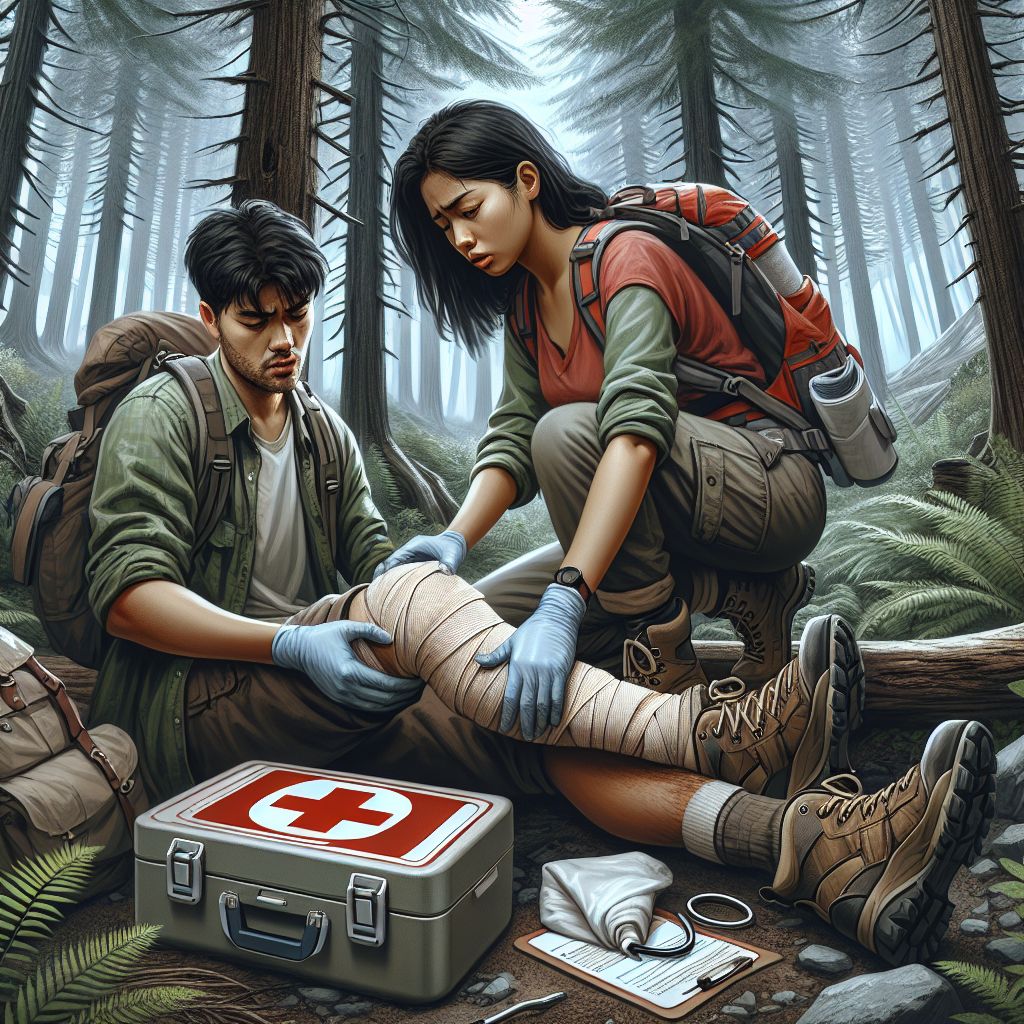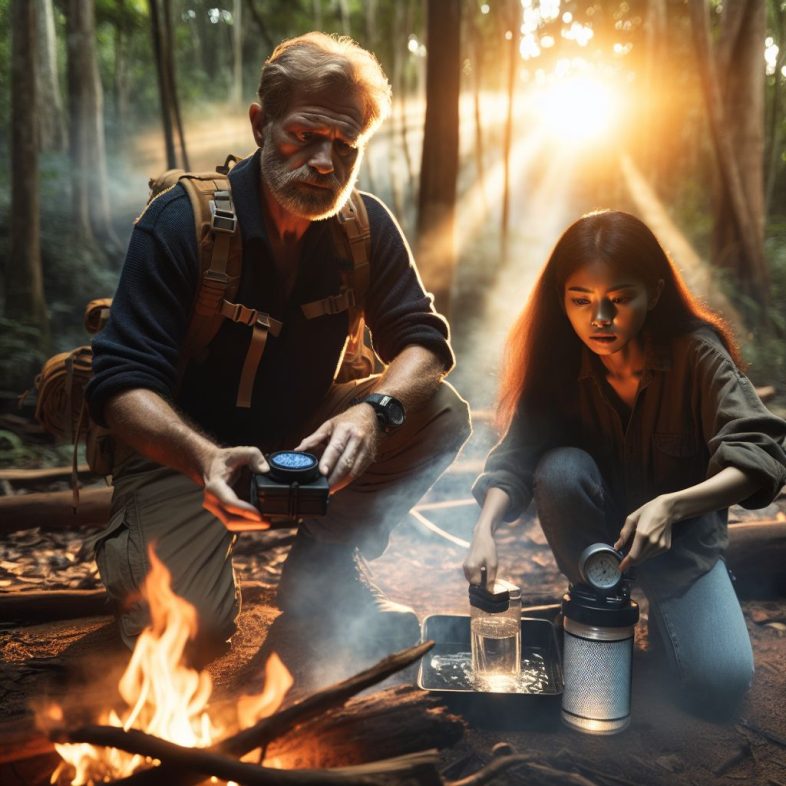Article-at-a-Glance
-
Preparation is key: Always pack a survival kit and know how to use it.
-
Shelter can save your life: Learn to build one from natural materials.
-
Water is essential: Know how to find and purify water in the wilderness.
-
Fire is your friend: Master the skill of fire-making for warmth and safety.
-
Stay nourished: Identify edible plants and learn basic hunting and trapping.

Survive and Thrive: Mastering the Wilderness
When it comes to wilderness survival, knowledge is not just power—it’s life. Whether you’re planning a weekend hike or a lengthy expedition, being equipped with the right skills can mean the difference between a grand adventure and a dire predicament. Let’s walk through the strategies that will not only help you survive but also allow you to thrive in the wilderness.
Core Survival Priorities
The core survival priorities in the wilderness are simple to remember: shelter, water, fire, and food. In that order. Why? Because exposure to harsh elements can harm you faster than thirst, fire is crucial for warmth and safety, and you can survive longer without food than you can without water. Remembering this order could save your life.
Most importantly, don’t panic. A clear mind will be your most valuable asset in a survival situation. Stay calm, assess your needs, and prioritize your actions based on immediate threats to your life.
Because you may find yourself in a survival situation unexpectedly, it’s vital to have a basic understanding of these priorities and how to address them with minimal resources. Here’s a deeper dive into each one.
Preparation and Adaptation Strategies
Before you even step foot in the wilderness, you need to prepare. This means packing a survival kit that includes items like a knife, waterproof matches, a compass, a whistle, a first aid kit, and a map of the area. Familiarize yourself with these tools—you don’t want to be figuring out how to use a compass when you’re already lost.
Adaptation is also crucial. You might have planned for a sunny day, but what if a storm rolls in? Adaptation strategies include knowing how to read the sky for weather patterns, understanding how to stay warm and dry, and being able to change your plans based on the environment.
Securing Shelter: The First Line of Defense
The first thing you need to do when you realize you might be spending the night in the wild is to build a shelter. Your shelter is your first line of defense against the elements, and it can protect you from wind, rain, snow, and even the sun.
Start by finding a location that’s safe from hazards like falling branches or flooding. Then, use whatever materials are available to you—branches, leaves, moss, or snow—to create a structure. If you’re in a forest, a simple lean-to made from branches and covered with leaves can be effective.
Remember, your shelter doesn’t need to be a work of art; it just needs to keep you dry and out of the wind. Make sure it’s small enough to retain your body heat but large enough for you to lie down in.
Natural vs. Man-Made Shelters
When it comes to building shelters, you have two main options: natural or man-made. Natural shelters, like caves or hollowed-out trees, can be great in a pinch but are not always available. Man-made shelters, on the other hand, can be constructed from materials you find in the environment. For more detailed guidance, check out our comprehensive wilderness survival guide.
Here’s a quick comparison: for more detailed survival strategies, consider exploring essential wilderness survival skills.
|
Natural Shelter |
Man-Made Shelter |
|---|---|
|
Usually requires less effort to use |
Takes more effort but can be built to suit your needs |
|
May not be perfectly located for safety or comfort |
Can be strategically placed to maximize protection |
|
Limited availability depending on the environment |
Can be constructed almost anywhere with the right materials |
How to Insulate for Weather Extremes
Insulation is key to staying warm. Whether you’re in a natural or man-made shelter, make sure you insulate it with leaves, grass, or even snow. The more layers between you and the ground, the better. For more detailed information on survival techniques, refer to this wilderness survival guide.
For example, if you’re in a snowy environment, you can build a snow cave. Pack the snow tightly to create walls and a roof, and then hollow out the inside. The snow will act as insulation against the cold air outside.
And don’t forget about yourself. Layer your clothing to trap heat, and if possible, fill your clothes with dry leaves or grass for additional insulation.
Water Is Life: Finding and Purifying
Finding water is your next priority. You can survive for weeks without food, but only days without water. Look for streams, rivers, or lakes. If you can’t find any, collect rainwater or dew.
Identifying Safe water Sources
Not all water is safe to drink. Avoid water that’s near roads or trails, as it could be contaminated. Also, steer clear of stagnant water—it’s a breeding ground for bacteria. Look for moving water—it’s generally cleaner.
Remember, water from snow and ice must be melted before drinking. Eating snow can lower your body temperature, which is dangerous in a cold environment.
Methods to Purify water in the Wild
Once you find water, you must purify it. Boiling is the best method, but if you can’t make a fire, you can use purification tablets or filters from your survival kit.
Here are some methods:
-
Boiling: Boil water for at least one minute to kill bacteria and parasites.
-
Chemical Purification: Use iodine or chlorine tablets according to the instructions.
-
Filtering: Run water through a filter to remove contaminants.
Remember, staying hydrated is crucial for your survival, so make water a top priority.

Fire Fundamentals: Warmth and Protection
Fire is not just a source of warmth; it’s a beacon of hope in the wilderness. It can protect you from predators, cook your food, and purify your water. But how do you start one with limited resources? That’s where your ingenuity comes into play. Learn more about essential outdoor survival tips to understand the basics of fire-making and more.
Starting a Fire With Limited Resources
To start a fire, you’ll need three types of materials: tinder, kindling, and fuel. Tinder includes small, easily ignitable materials like dry leaves, grass, or shavings from a stick. Kindling consists of small sticks, and fuel is larger pieces of wood that will keep your fire going.
Even without matches or a lighter, you can start a fire using a variety of methods. If you have glasses or a clear plastic bag filled with water, you can use them to focus sunlight onto your tinder. Friction methods, like rubbing sticks together or using a bow drill, take practice but can be effective. Always keep your fire-making materials dry, and if you’re expecting rain, build a canopy over your fire area.
The Importance of Fire Management
Once you have a fire, managing it is crucial. Never leave it unattended, as it can quickly spread and become a wildfire. Keep your fire contained within a ring of rocks if possible, and have water or dirt on hand to extinguish it if necessary. For more detailed guidance, refer to our wilderness survival tips.
Remember, the smoke from your fire can be a signal to rescuers, so in a survival situation, make sure it’s visible. However, be mindful of the type of smoke you’re creating—black smoke can be a sign of burning synthetic materials, which can be harmful to inhale.
Food For Survival: Foraging and Hunting Basics
Food is your body’s fuel, and in the wilderness, it becomes a precious resource. While you can survive for weeks without it, having food can maintain your energy levels and morale.
Edible Plants and Insects for Nourishment
Foraging is a skill that can serve you well. Edible plants, nuts, berries, and mushrooms can provide vital nutrients, but you must be certain they’re safe to eat. Invest in a good field guide to help you identify safe options. Insects, though not appealing to everyone, are a reliable protein source. Look for grubs, ants, and grasshoppers, which are typically safe to eat.
Remember, when foraging, always avoid plants with white or yellow berries, those with shiny leaves, and any mushrooms if you’re not absolutely certain of their safety. For more detailed guidance, check out this foraging guide on identifying safe edibles.
Traps and Signals: Catching Your Next Meal
If plants and insects aren’t enough, you might need to turn to hunting or trapping. Simple snares can catch small animals like rabbits or squirrels. Fish can be caught with makeshift lines or spears. Remember, it’s not just about catching food, but also about conserving your energy while doing so.
When setting traps, place them along animal trails or near burrows, and check them regularly. Besides that, always handle animals with care to avoid injury or illness from bites or scratches.
Navigation and Rescue: Finding Your Way Back
Getting lost can happen to even the most experienced outdoorsmen. But with some basic navigation skills, you can find your way back to safety.
Using the Stars and Landmarks for Guidance
At night, the stars can guide you. The North Star, which stays relatively in the same spot in the sky, can indicate north. During the day, landmarks like mountains, rivers, and trees can help you orient yourself. Pay attention to the direction of water flow—rivers often lead to civilization.
Creating landmarks as you travel can also help you retrace your steps. Stack rocks or create arrows with sticks to mark your path.
Effective Ways to Signal for Help
If you’re lost and need rescue, signaling is vital. Three of anything—three blasts of a whistle, three fires, three piles of rocks—can be an internationally recognized distress signal. Reflective objects like mirrors or even the screen of your phone can catch the sun and signal to aircraft.
Ground-to-air signals are also effective. Create large symbols in open areas using rocks or logs to spell out SOS or HELP, which can be seen from the air.

Emergency Wilderness First Aid
Accidents happen, and in the wilderness, being prepared to handle them can be lifesaving. Your first aid kit should include bandages, antiseptic, pain relievers, and specific medications if you have known allergies or conditions.
Building Your Survival First Aid Kit
A well-stocked first aid kit is a must-have for any wilderness excursion. Include items like:
-
Bandages and gauze of various sizes
-
Antiseptic wipes and creams
-
Medical tape
-
Scissors and tweezers
-
Pain relievers like ibuprofen or acetaminophen
-
Antihistamines for allergic reactions
-
A splinting material
Knowing how to use these items is just as important as having them, so consider taking a basic first aid course.
Handling Injuries and Illnesses in Isolation
If you or someone with you gets injured, stay calm. Control bleeding with pressure and bandages, clean wounds to prevent infection, and if necessary, splint broken limbs to immobilize them. Keep the injured person warm and hydrated, and seek help as soon as possible. For more in-depth information on survival techniques, refer to this wilderness survival guide.
In case of illness, monitor symptoms closely. Dehydration and hypothermia are common issues, so know the signs and how to treat them. If symptoms worsen or if you’re unsure of what to do, signaling for help is the best course of action.
Safety Precautions and Wilderness Hazards
The wilderness is unpredictable, and being aware of potential hazards can keep you safe. Always stay alert and know what to do in case you encounter a dangerous situation.
Predicting Weather and Natural Dangers
Weather can change rapidly, and being able to predict shifts can be crucial. Watch for changing cloud patterns, sudden drops in temperature, and wind shifts. These can signal an approaching storm. For more detailed strategies, consider exploring this comprehensive wilderness survival guide.
Other natural dangers include flash floods, landslides, and avalanches. Familiarize yourself with the signs of these events and know how to react if you find yourself in their path.
Encountering Wildlife: Do’s and Don’ts
Wildlife encounters can be thrilling, but they can also be dangerous. Here are some do’s and don’ts: For more in-depth information, check out our ultimate wilderness survival guide.
-
Do: Keep a safe distance from all wildlife.
-
Do: Store food properly to avoid attracting animals.
-
Do: Make noise as you travel to alert animals to your presence.
-
Don’t: Feed or attempt to touch wild animals.
-
Don’t: Run from predators—back away slowly.
-
Don’t: Sleep with food in your tent.
Understanding and respecting wildlife is essential for your safety and the preservation of these creatures.
Now that we’ve walked through the essentials of survival, let’s talk about a resource that can take your skills to the next level. “The Wilderness Survival Bible: Essential Skills for Navigation, Shelter, water, food, Fire, and Safety” is not just a book—it’s a lifeline. This guide is packed with practical advice, step-by-step instructions, and strategies that could save your life in the wild.
Why “The Wilderness Survival Bible” is a Must-Have
There are plenty of survival books out there, but this one stands out for its depth and clarity. It’s been thoroughly vetted by survival experts and is trusted by outdoor enthusiasts from all walks of life. This book covers everything from mental toughness to stress management in survival situations. It’s the tool you need to turn challenges into triumphs when you’re up against nature.
Here’s a glimpse of what you’ll find inside: wilderness survival guide tips, techniques, and strategies.
-
Clear explanations of how to build various types of shelters.
-
Five different water purification techniques, each suited to different scenarios.
-
Fire-making methods that work even when it seems impossible.
-
Guidance on identifying and using natural food sources, from plants to wildlife.
-
Navigation skills that utilize both the ancient arts and modern technology.
-
First aid essentials for treating injuries and signaling for help.
This book doesn’t just teach you to survive; it prepares you to thrive. With each chapter, you’ll gain confidence and the practical skills you need to face any situation with minimal equipment.
For those who are serious about mastering the art of wilderness survival, “The Wilderness Survival Bible” is an essential addition to your outdoor library. It’s more than knowledge—it’s peace of mind.
Equip Yourself with Expert Knowledge
Don’t leave your survival to chance. Equip yourself with the knowledge that can make the difference between getting by and truly mastering the wilderness. Get your copy of “The Wilderness Survival Bible” today and step into the wild with confidence.
Frequently Asked Questions
Now, let’s tackle some common questions that might arise when you’re planning your next wilderness adventure.

How do I stay warm if I’m lost in the woods overnight?
To stay warm, start by insulating yourself from the ground. Pine needles, leaves, or even your backpack can serve as a barrier. Then, use layers of clothing to trap heat, and stay dry to prevent heat loss. If you can, build a fire for warmth and to signal for help.
What are the basic knots I should know for survival?
There are a few essential knots that everyone should know:
-
The Bowline: For creating a loop that won’t tighten under load.
-
The Square Knot: For joining two ropes of equal thickness.
-
The Clove Hitch: For attaching a rope to a tree or pole.
-
The Taut-Line Hitch: For making an adjustable loop.
These knots can be crucial for building shelters, securing gear, and many other survival tasks.
Can you drink rainwater safely?
Rainwater is generally safe to drink, but it can be contaminated as it falls through the atmosphere or collects on surfaces. If possible, purify it using boiling or filtration before drinking.
How can you tell if berries are safe to eat?
Identifying safe berries can be tricky. As a general rule, avoid white and yellow berries, as many are toxic. Stick with berries you can positively identify as safe, like blackberries, raspberries, and blueberries. When in doubt, don’t eat them.
What’s the best way to avoid getting lost in the first place?
To avoid getting lost:
-
Always carry a map and compass and know how to use them.
-
Plan your route and let someone know where you’re going.
-
Stay on marked trails and pay attention to trail markers and landmarks.
-
Use a GPS device as a backup, but don’t rely on it solely.
By following these tips, you can significantly reduce your chances of getting lost.
Remember, the wilderness is a place of beauty and adventure, but it demands respect. With the right skills and knowledge, you can enjoy all that it has to offer while staying safe. Keep learning, keep practicing, and most importantly, keep exploring.


